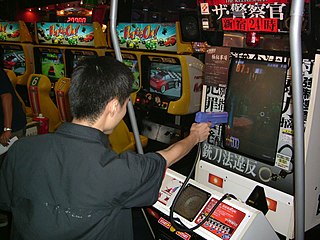
An arcade video game takes player input from its controls, processes it through electrical or computerized components, and displays output to an electronic monitor or similar display. All arcade video games are coin-operated or accept other means of payment, housed in an arcade cabinet, and located in amusement arcades alongside other kinds of arcade games. Until the early 2000s, arcade video games were the largest and most technologically advanced segment of the video game industry.

Pac-Man, originally called Puck Man in Japan, is a 1980 maze video game developed and released by Namco for arcades. In North America, the game was released by Midway Manufacturing as part of its licensing agreement with Namco America. The player controls Pac-Man, who must eat all the dots inside an enclosed maze while avoiding four colored ghosts. Eating large flashing dots called "Power Pellets" causes the ghosts to temporarily turn blue, allowing Pac-Man to eat them for bonus points.

Ms. Pac-Man is a 1982 maze arcade video game developed by General Computer Corporation and published by Midway. It is a spin-off sequel to Pac-Man (1980) and the first entry in the series to not be made by Namco. Controlling the title character, Pac-Man's wife, the player is tasked with eating all of the pellets in an enclosed maze while avoiding four colored ghosts. Eating the larger "power pellets" lets the player eat the ghosts, who turn blue and flee.
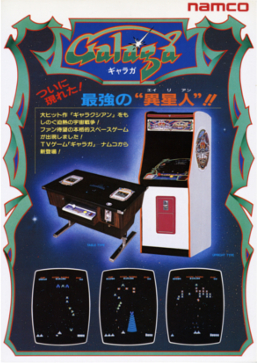
Galaga is a 1981 fixed shooter arcade video game developed and published by Namco. In North America, it was released by Midway Manufacturing. It is the sequel to Galaxian (1979), Namco's first major video game hit in arcades. Controlling a starship, the player is tasked with destroying the Galaga forces in each stage while avoiding enemies and projectiles. Some enemies can capture a player's ship via a tractor beam, which can be rescued to transform the player into a "dual fighter" with additional firepower.

Dig Dug is a maze arcade video game released by Namco in 1982. It was distributed in North America by Atari, Inc. The player digs underground tunnels to attack enemies in each level, by either inflating them to bursting or crushing them underneath rocks.
The golden age of arcade video games was the period of rapid growth, technological development, and cultural influence of arcade video games from the late 1970s to the early 1980s. The release of Space Invaders in 1978 led to a wave of shoot-'em-up games such as Galaxian and the vector graphics-based Asteroids in 1979, made possible by new computing technology that had greater power and lower costs. Arcade video games switched from black-and-white to color, with titles such as Frogger and Centipede taking advantage of the visual opportunities of bright palettes.
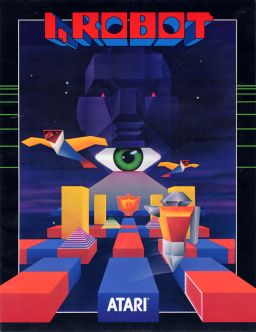
I, Robot is an arcade shooter game developed and released in 1984 by Atari, Inc. Designed by Dave Theurer, only a total of 750–1000 arcade cabinets were produced. The arcade machine comes with two games. The first is I, Robot, a multi-directional shooter that has the player assume the role of "Unhappy Interface Robot #1984", a servant bot that rebels against Big Brother. The object of the game involves the servant bot going through 126 levels, turning red squares to blue to destroy Big Brother's shield and eye. The player can switch to the second game, Doodle City, a drawing tool that lasts for three minutes.

Rally-X is a maze chase arcade video game developed in Japan and Germany by Namco and released in 1980. In North America, it was distributed by Midway Manufacturing and in Europe by Karateco. Players drive a blue Formula One race car through a multidirectional scrolling maze to collect yellow flags. Boulders block some paths and must be avoided. Red enemy cars pursue the player in an attempt to collide with them. Red cars can be temporarily stunned by laying down smoke screens at the cost of fuel. Rally-X is one of the first games with bonus stages and continuously-playing background music.
Mario Kart Arcade GP is sub-series of arcade games from Nintendo's Mario Kart series developed specifically for arcades in collaboration with Namco. To date, four entries have been released—Mario Kart Arcade GP (2005), Mario Kart Arcade GP 2 (2007), Mario Kart Arcade GP DX (2013), and Mario Kart Arcade GP VR (2017). The first three entries are considered to be relatively rare outside of Japan, with the fourth title not seeing a release outside of Japan at all. The game's have been generally been well-received by critics, who have praised the game's transition of traditional Mario Kart gameplay into an arcade game format, thought to-date, while lamenting that none of the entries have been released outside of the arcade format onto any of Nintendo's home video game consoles.

Pac-Attack, also known as Pac-Panic, is a 1993 falling-tile puzzle video game developed and published by Namco for the Super Nintendo Entertainment System and Sega Genesis. Versions for the Game Boy, Game Gear and Philips CD-i were also released. The player is tasked with clearing out blocks and ghosts without them stacking to the top of the playfield — blocks can be cleared by matching them in horizontal rows, while ghosts can be cleared by placing down a Pac-Man piece that can eat them. It is the first game in the Pac-Man series to be released exclusively for home platforms.
Namco Museum is a series of video game compilations developed and published by Bandai Namco Entertainment for home video game consoles. The first title in the series, Namco Museum Vol. 1, was released for the PlayStation in 1995. Entries in the series have been released for multiple platforms, including the Game Boy Advance, PlayStation 2, PlayStation Portable, Nintendo DS and Xbox 360. the latest being Namco Museum Archives Vol. 2, released in 2020.
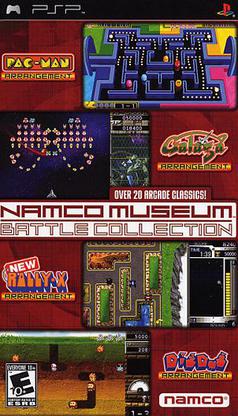
Namco Museum Battle Collection is a 2005 video game compilation developed by Tose and published by Namco for the PlayStation Portable; the first Namco Museum since the PS1 series to be developed in Japan. It includes 21 games - four of these are brand-new "arrangement" remakes of older Namco games, while the rest are emulated ports of Namco arcade games from the 1970s and 1980s. These ports include an options menu that allows the player to modify the in-game settings, such as the screen orientation and number of lives. Players can send one-level demos to a friend's console via the "Game Sharing" option in the main menu.
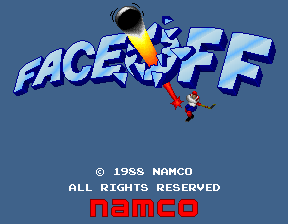
Face Off is an ice hockey arcade game developed and released by Namco for Japan only in 1988. Up to four players control players from one of eight hockey teams against each other, the objective being to score the most points before the timer ends. Similar to Namco's own Final Lap, multiple cabinets can be linked together to enable multiplayer play. It runs on the Namco System 1 arcade board. Face Off received a favorable critical reception for its visuals and gameplay. A digital re-release for the Wii Virtual Console was released in Japan in 2009.
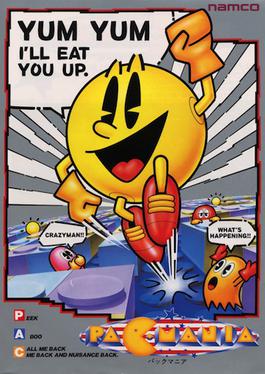
Pac-Mania is a cavalier perspective maze game that was developed and released by Namco for arcades in 1987. In the game, the player controls Pac-Man as he must eat all of the dots while avoiding the colored ghosts that chase him in the maze. Eating large flashing "Power Pellets" will allow Pac-Man to eat the ghosts for bonus points, which lasts for a short period of time. A new feature to this game allows Pac-Man to jump over the ghosts to evade capture. It is the ninth title in the Pac-Man video game series and was the last one developed for arcades up until the release of Pac-Man Arrangement in 1996. Development was directed by Pac-Man creator Toru Iwatani. It was licensed to Atari Games for release in North America.

Virtuality was a range of virtual reality machines produced by Virtuality Group, and found in video arcades in the early 1990s. The machines delivered real-time VR gaming via a stereoscopic VR headset, joysticks, tracking devices and networked units for a multi-player experience.

A first-person shooter (FPS) is a video game centered on gun fighting and other weapon-based combat seen from a first-person perspective, with the player experiencing the action directly through the eyes of the main character. This genre shares multiple common traits with other shooter games, and in turn falls under the action games category. Since the genre's inception, advanced 3D and pseudo-3D graphics have proven fundamental to allow a reasonable level of immersion in the game world, and this type of game helped pushing technology progressively further, challenging hardware developers worldwide to introduce numerous innovations in the field of graphics processing units. Multiplayer gaming has been an integral part of the experience, and became even more prominent with the diffusion of internet connectivity in recent years.

Namco Museum Vol. 1 is a 1995 arcade video game compilation developed and published by Namco for the PlayStation. The collection includes seven arcade games developed by the company that were originally released in the 1980s, such as Pac-Man, Galaga and Pole Position. The compilation features a 3D open-world virtual museum that the player can interact with, the games being housed in themed rooms with exhibits, such as promotional flyers, cabinet artwork and instruction cards. Players can also view Namco product catalogs, promotional pamphlets and front cover scans of the company's Japanese press literature.

An arcade video game is an arcade game where the player's inputs from the game's controllers are processed through electronic or computerized components and displayed to a video device, typically a monitor, all contained within an enclosed arcade cabinet. Arcade video games are often installed alongside other arcade games such as pinball and redemption games at amusement arcades. Up until the late 1990s, arcade video games were the largest and most technologically advanced sector of the video game industry.

The Pac-Man 40th Anniversary was a celebration of the Pac-Man series of video games since the release of the arcade cabinet Pac-Man on May 22, 1980. Bandai Namco celebrated the anniversary through business ventures with video games, events, clothing and other forms of merchandise. The anniversary took place throughout 2020, and ended in early 2021.
Arcade1Up is a computer hardware production company that specializes in the production of working 3/4 scale arcade video games using modern components and emulation.
















